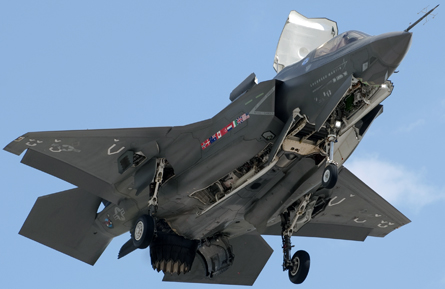The US Air Force has concluded that the short take-off vertical landing (STOVL) Lockheed Martin F-35B- model aircraft cannot generate enough sorties to meet its needs; therefore the service will not consider replacing the Fairchild Republic A-10 Warthog close air support jet with that variant.
Meanwhile, the USAF and the US Navy are hoping to more closely integrate their forces as part of the US Department of Defense's (DoD) new AirSea battle concept.
"The F-35B is well-suited to support of the Marine Air Ground Taskforce (MAGTF) in very austere locations," says USAF chief of staff Gen Norton Schwartz, speaking at an event hosted by the Brookings Institution in Washington, D.C. "But the reality is, is that scenario is not a high sortie generation scenario."
The USAF and the US Navy need greater sortie generation rates than the F-35B can provide, Schwartz says.
"What we think is needed is high sortie generation in order to provide persistence over the target and to engage the variety of targets that may exist," he says. "Not in a confined battlespace, but more on a theatre basis."
 |
|---|
©Lockheed Martin |
The F-35B is an interesting aircraft, Schwartz says. But while the USAF had at one time considered the variant as a potential replacement for the A-10, given the fiscal constraints the services faces and the need to generate more sorties, the USAF will not buy the F-35B, he says.
Retired Lt Gen George Trautman, a former US Marine Corps (USMC) deputy commandant for aviation, disputes Schwartz's assertion that the F-35B cannot generate as many sorties as the A or C model aircraft.
"The F35B has highest sortie generation rate among the three JSF [Joint Strike Fighter] variants," Trautman says. "There may be other reasons the air force doesn't want the B, but sortie rate isn't a factor."
In fact, the USMC's concept of operations depends on the STOVL variant generating more sorties more rapidly than other JSF models, says retired USMC Lt Gen Emerson Gardner, a former naval aviator.
The key performance parameters (KPP) for the F-35 require higher sortie rates for the B-model at four sorties per day. The A and C models are only required to generate three sorties per day.
"So far in SDD [System Development and Demonstration], all three variants are on track to exceed their KPPs at the completion of SDD," Gardner says. "The B looks to come in at about six sorties per day, the A at about 3.5 and the C at close to four."
While USAF will not consider buying the F-35B, the service is fully committed to buying its own conventional take-off F-35A variant. Fighters like the stealthy F-35 are not in any danger of being replaced by unmanned combat aircraft anytime in the near future because those machines are not yet capable of flying in airspace protected by advanced integrated air defence systems.
"The reality is, is that at least in the current [generation], a remotely piloted aircraft cannot survive in contested airspace," Schwartz says.
Stealthy fifth-generation fighters, the Northrop Grumman B-2, the nascent USAF Long Range Strike Bomber (LRS-B), are critical capabilities for the US military to operate inside anti-access/area-denial (A2/AD) environments.
Those types of aircraft "will allow us to operate within contested airspace and assert our access," Schwartz says, "Which is the fundamental tenant of AirSea battle."
The DoD's new AirSea battle concept, while still integrating the USMC and US Army, is primarily driven by the USN and USAF. At its most basic level, the concept calls for the seamless integration of USN and USAF assets so that the two service's aircraft, ships, submarines and space assets all work together, says USN chief of naval operations Admiral Jonathan Greenert.
"Our links need to be similar," Greenert says, "Or minimally compatible."
Eventually, if everything goes according to the USAF and USN vision, a USAF Boeing E-3 Sentry or USN Northrop Grumman E-2D Hawkeye could seamlessly share a common picture with an Aegis cruiser and F-22 or Boeing F/A-18 at the same time.
The two services are already working on a next generation data-link to share all that information, Schwartz says. But for existing legacy platforms, there will need to be "gateways", like the Battlefield Airborne Communications Node (BACN).
But there is the danger of information overload. At the senior leadership level, the air or maritime joint component commanders might not need to know all of the detailed information that the other needs. Already, there might be too much extraneous data, Greenert says. In the future, that information will need to be filtered properly.
"I don't want to everything that the air component commander knows," he says. "We're already almost overloaded from that perspective we want to share what the...critical contacts of interest are cross domain."
Source: Flight International



















